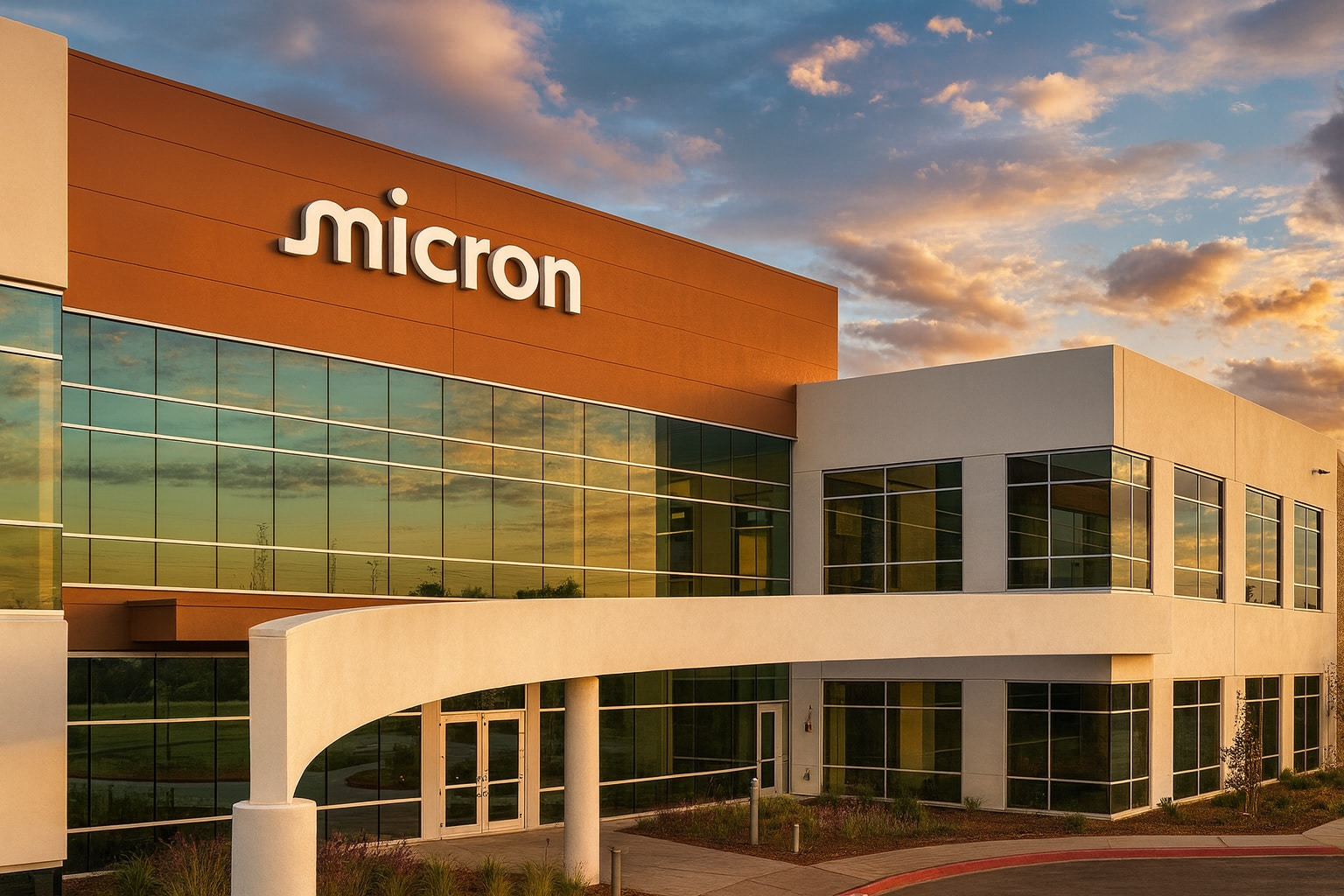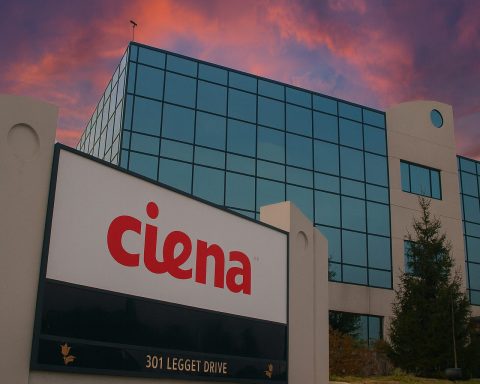Micron Technology, Inc. (NASDAQ: MU) is back in the spotlight today as investors digest a sharp pullback in the share price, a revised construction timeline for its $100 billion New York “megafab,” and Wall Street’s increasingly aggressive forecasts for AI‑driven earnings growth.
After touching fresh record highs above $260 earlier this week, Micron shares slid roughly 13% in two sessions amid broader weakness in AI and semiconductor names. [1] Yet even after the sell‑off, the stock is still up well over 150% year‑to‑date, and some analysts now see room for substantial further upside.
Key takeaways
- Stock volatility: MU pulled back to around $228.50 after a two‑day, ~13% slide from Monday’s intraday high near $261, even as year‑to‑date gains remain close to 180–190%. [2]
- New York megafab delay: Micron’s final environmental impact statement (EIS) shows construction on its $100 billion Clay, New York campus shifting out by 2–3 years, with the first DRAM fab now expected to be operational around 2029–2030. [3]
- RBC conference today: Company executives are scheduled for a fireside chat at RBC Capital Markets’ 2025 Global Technology, Internet, Media & Telecommunications Conference at 6:00 a.m. Mountain Time. [4]
- Street‑high target from Morgan Stanley: Analyst Joseph Moore raised Micron’s price target to $325 and named MU a “Top Pick,” citing a rare memory‑pricing upcycle that could push 2026 EPS above $25. [5]
- Big money repositioning: New 13F filings show major institutions such as Primecap Management and Clal Insurance trimming Micron holdings, even as overall institutional ownership stays above 80%. [6]
- AI boom still driving fundamentals: Micron just wrapped a record fiscal 2025, with Q4 revenue up 46% year over year to $11.32 billion and AI‑data‑center products now accounting for a large share of sales. [7]
Micron stock today: from record highs to a sharp pullback
On Monday, Micron’s share price surged to a new 52‑week (and record) high of $260.58 after Rosenblatt Securities lifted its price target from $250 to $300 and reiterated a buy rating. [8] The stock closed that session at about $251, extending a remarkable rally fueled by AI memory demand.
Since then, the mood has shifted.
- By Tuesday’s close, MU had slipped to around $228.50, a decline of about 5.6% on the day and roughly 13% below Monday’s peak, with heavy trading volume north of 30 million shares. [9]
- A Smartkarma market‑movers note pegged Micron’s year‑to‑date gain at around +187%, underscoring how steep the run‑up has been even after the recent drop. [10]
- FXLeaders highlighted the two‑day slide as a classic “AI hangover” move: MU rallied hard on enthusiasm for high‑bandwidth memory (HBM), then sold off alongside sector downgrades and rising concerns that the AI infrastructure trade may have gotten ahead of itself. [11]
Early today, futures and pre‑market data suggested a modest bounce, with one snapshot showing Micron trading in the low‑$230s before the open, recovering a small portion of Tuesday’s losses. [12]
For now, the pullback looks more like position‑trimming in a crowded winner than a fundamental turn in Micron’s story—but it does raise the stakes for what management says later today at the RBC conference.
Morgan Stanley’s $325 call: “Time to load up” on MU?
Even as the stock chops around, Wall Street’s fundamental view of Micron keeps getting more bullish.
In a widely discussed note, Morgan Stanley’s Joseph Moore:
- Raised his Micron price target from $220 to $325, the highest on Wall Street, and reiterated a Buy rating. [13]
- Called Micron a “Top Pick”, arguing the company is entering a rare, powerful surge in memory pricing driven by AI data‑center demand. [14]
- Pointed out that DDR5 DRAM prices have roughly tripled in recent months, echoing some of the sharpest memory upcycles of the 1990s and surpassing the intensity of the 2017–2018 boom. [15]
- Forecast more than $25 in EPS for 2026, materially above current consensus and implying that valuation concerns may be “secondary” to coming earnings revisions. [16]
A separate write‑up syndicated via German outlet boerse‑global framed Micron as entering “unprecedented growth territory,” citing Morgan Stanley’s base $325 target and a bull‑case scenario of up to $420, which would imply ~70% upside from recent levels. It also highlighted that Micron’s fiscal 2025 revenue reached around $37.4 billion, up about 50% year on year, with HBM revenue alone running at roughly $8 billion annualized based on fourth‑quarter figures. [17]
Taken together, the Morgan Stanley call and surrounding commentary reinforce a theme: if the AI‑driven memory upcycle lasts into 2026, today’s volatility could prove a detour rather than a top. But that bullish view is increasingly consensus—and a lot of good news is already priced in.
New York “megafab” delay: what Micron’s new EIS reveals
The other big Micron story today is physical, not financial: the company’s $100 billion DRAM campus in Clay, New York.
A new article in Cleanroom Technology details how Micron’s final Environmental Impact Statement (EIS), released November 7, outlines a revised construction schedule: [18]
- Construction on the first fabrication facility, previously expected to begin in 2025, is now effectively pushed out by roughly 2–3 years.
- The EIS states that Fabs 1 and 2 are expected to be operational by 2029 and 2030, respectively, with Fabs 3 and 4 coming online in 2035 and 2041. [19]
- Once fully built, the Clay campus is intended to become the largest U.S. producer of DRAM, supporting applications spanning AI, defense, cybersecurity, aerospace, and consumer devices. [20]
Coverage from construction‑industry outlets adds further color:
- ConstructConnect reports that construction on the first fab is now slated to start in 2026, with initial operations shifting from an earlier 2028 goal to around 2030. Full build‑out of all four fabs is now expected by 2041, with full production ramping toward 2045. [21]
- The project is expected to require up to 4,200 construction workers on‑site at peak and ultimately support roughly 9,000 permanent Micron jobs plus around 40,000 additional jobs across New York State. [22]
CHIPS Act funding and Idaho shift
The New York project is heavily intertwined with U.S. industrial policy:
- Under the CHIPS and Science Act, the U.S. Department of Commerce has committed about $6.14 billion in federal support for Micron’s U.S. projects, including two fabs in Clay and one in Boise, Idaho. [23]
- Reporting from Tom’s Hardware indicates Micron has reallocated roughly $1.2 billion of CHIPS funding from New York to Idaho, trimming Clay’s share from about $4.6 billion to $3.4 billion while accelerating a second fab in Idaho. [24]
Micron insists the New York fabs remain “on track” with its latest timelines and attributes the updated schedule to realistic industry‑wide construction experience rather than a change in intent. [25] Still, for investors and policymakers hoping for rapid on‑shore DRAM capacity, today’s EIS‑driven delay underscores how multi‑decade and capital‑intensive this build‑out really is.
RBC Global Technology Conference: what to listen for today
Micron executives are scheduled to speak today, November 19, at RBC Capital Markets’ 2025 Global Technology, Internet, Media & Telecommunications Conference in New York. The company previously announced a fireside chat at 6:00 a.m. Mountain Time, accessible via live webcast and replay on Micron’s investor relations site. [26]
While no prepared remarks have been published yet, investors are likely to focus on:
- AI data‑center demand: How sustainable is the current order pipeline for HBM and high‑capacity DRAM into 2026?
- Supply discipline: Does Micron plan further capacity or capex adjustments in light of soaring prices and competitors ramping HBM4?
- U.S. manufacturing roadmap: How management frames the New York megafab timeline relative to accelerated investment in Idaho. [27]
- Near‑term demand signals: Any commentary on hyperscaler spending, AI GPU launches, and server refresh cycles following the company’s strong Q4 guidance. [28]
Given the recent share‑price volatility, even subtle tone shifts could move the stock.
Institutional and insider moves: big holders trim, but ownership remains strong
A string of 13F filings highlighted by MarketBeat today shows both large and small institutions fine‑tuning their exposure to MU: [29]
- Primecap Management Co. CA reduced its Micron stake by 15.6% in Q2 but still holds about 31.5 million shares, worth roughly $3.88 billion, making MU its 4th‑largest position and giving it around 2.8% ownership of Micron’s shares outstanding. [30]
- Clal Insurance Enterprises Holdings Ltd cut its position by 11.8% to about 796,000 shares, valued near $98 million, with Micron still representing roughly 1% of Clal’s portfolio. [31]
- A cluster of smaller advisers—ranging from First Command Advisory Services to AlphaQuest and Hilltop National Bank—have either initiated or increased small MU positions, often measured in a few hundred shares. [32]
Across these filings, institutional ownership remains high at roughly 81%, underscoring that Micron is still very much a “big‑money” stock. [33]
On the insider side, recent months have seen notable selling:
- CAO Scott R. Allen sold about 8,800 shares around $210,
- EVP Scott J. Deboer sold 82,000 shares near $223, and
- CFO Mark J. Murphy disposed of 126,000 shares at roughly $225,
for a combined insider sale value above $85 million over the last quarter. [34] Insiders still hold only about 0.3% of the company—typical for a mature large‑cap semiconductor name, but something investors often watch when momentum has been as strong as Micron’s.
Fundamentals: record FY25 results powered by AI data centers
Behind the headlines, Micron is coming off one of the strongest years in its history.
In its fiscal Q4 2025 results (for the quarter ended August 28), the company reported: [35]
- Revenue of $11.32 billion, up 22% quarter‑over‑quarter and 46% year‑over‑year.
- Non‑GAAP EPS of $3.03, beating consensus estimates around $2.86.
- Full‑year revenue of $37.38 billion, up about 49% from fiscal 2024.
- Operating cash flow of $17.5 billion for the year, roughly double the prior year’s level.
Barron’s and other outlets have emphasized how much of this growth is coming from AI infrastructure: in Q4, Micron’s advanced memory for AI data centers accounted for roughly 40% of total revenue, up from about 19% a year earlier. [36]
That mix shift is central to the bullish case: data‑center AI workloads are less cyclical than PC or smartphone memory, and HBM products carry significantly higher margins.
Long‑term performance: Micron as a compounding story
Today’s Zacks‑highlighted stat captures just how far Micron has come over the last decade: a $1,000 investment in MU 10 years ago would be worth roughly $14,600 today, a gain of about 1,364% as of November 19, 2025. [37]
Of course, that journey hasn’t been smooth—Micron remains tied to the notoriously cyclical memory market—but the AI era appears to be reshaping the cycle in Micron’s favor.
What to watch next
For investors tracking Micron in the days ahead, a few catalysts stand out:
- RBC conference commentary (today)
Any hints on 2026 HBM capacity, DRAM pricing discipline, or capex plans could influence how realistic Morgan Stanley’s $25 EPS/2026 scenario looks. [38] - Follow‑through on Clay, New York and Idaho
The EIS has clarified the timeline; now investors will watch for concrete construction milestones, CHIPS grant disbursement updates, and signs that the Idaho acceleration can offset New York’s delay. [39] - Next earnings and guidance
Market calendars show Micron’s Q1 fiscal 2026 results and call planned for mid‑December, another key moment to test whether the AI demand story is holding up into the new fiscal year. [40] - Sector sentiment
Recent AI‑chip downgrades show how quickly enthusiasm can swing. If investors decide the AI infrastructure trade has overshot, even strong fundamental names like Micron could remain volatile. [41]
A quick note
Nothing here is investment advice—just a synthesis of today’s Micron news and public data. If you’re considering trading or investing in MU, it’s important to review Micron’s own filings and presentations, understand your risk tolerance, and, if needed, speak with a qualified financial adviser.
References
1. www.fxleaders.com, 2. www.smartkarma.com, 3. www.cleanroomtechnology.com, 4. www.globenewswire.com, 5. www.tipranks.com, 6. www.marketbeat.com, 7. www.globenewswire.com, 8. www.americanbankingnews.com, 9. www.smartkarma.com, 10. www.smartkarma.com, 11. www.fxleaders.com, 12. finance.yahoo.com, 13. www.tipranks.com, 14. www.tipranks.com, 15. www.ad-hoc-news.de, 16. www.tipranks.com, 17. www.ad-hoc-news.de, 18. www.cleanroomtechnology.com, 19. www.cleanroomtechnology.com, 20. www.cleanroomtechnology.com, 21. news.constructconnect.com, 22. news.constructconnect.com, 23. www.cleanroomtechnology.com, 24. www.tomshardware.com, 25. www.tomshardware.com, 26. www.globenewswire.com, 27. www.tomshardware.com, 28. www.globenewswire.com, 29. www.marketbeat.com, 30. www.marketbeat.com, 31. www.marketbeat.com, 32. www.marketbeat.com, 33. www.marketbeat.com, 34. www.marketbeat.com, 35. www.globenewswire.com, 36. www.barrons.com, 37. www.zacks.com, 38. www.tipranks.com, 39. www.cleanroomtechnology.com, 40. us.trendlyne.com, 41. www.fxleaders.com







